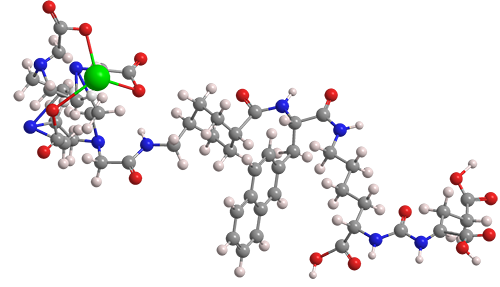What molecule am I?


Lutetium-177 vipivotide tetraxetan1 is a widely approved breakthrough drug for metastatic prostate cancer. It is manufactured and distributed by Novartis (Basel, Switzerland) under the trade name Pluvicto. According to a recent Novartis press release, “Pluvicto shows statistically significant and clinically meaningful radiographic progression-free survival benefit in patients with PSMA-positive metastatic castration-resistant prostate cancer.”
PSMA, or prostate-specific membrane antigen, is the target of the radioactive 177Lu atom in the molecule, which is surrounded by the complex vipivotide tetraxetan2 ligand that binds to the PSMA-expressing tumor cells. The drug, in solution form, is administered intravenously.
Pluvicto was approved first by the US Food and Drug Administration in March 2022. Approvals by the United Kingdom, Canada, and the European Medicines Agency followed later in 2022.
Pluvicto is considered to be a safe drug, although Novartis advises that to minimize radiation exposure, patients should avoid close contact with others for at least 2 days after injection and with children and pregnant women for 7 days. Patients should also urinate as often as possible to reduce the risk of bladder irradiation. The drug’s most common side effects include fatigue, dry mouth, nausea, anemia, decreased appetite, and constipation.
Safety data sheets for Pluvicto are not available, but Novartis published detailed safety information for the drug earlier this year.
1. SciFinder: Lutetate(3–)-177Lu, [N2-[[[(1S)-1,3-dicarboxypropyl]amino]carbonyl]-N6-[3-(2-naphthalenyl)-N-[[trans-4-[[[2-[4,7,10-tris[(carboxy-κO)methyl]-1,4,7,10-tetraazacyclododec-1-yl-κN1,κN4,κN7,κN10]acetyl-κO]amino]methyl]cyclohexyl]carbonyl]-L-alanyl]-L-lysinato(6–)]-, hydrogen (1:3).
2. CAS Reg. No. 1702967-37-0.
Molecules from the journals
(+)-Xyloketal B1 is one of five pentacyclic compounds isolated in 2001 from mangrove fungus species of the genus Xylaria that grow on the coast of the South China Sea. Xyloketal B has shown potential for treating conditions such as Alzheimer’s disease and atherosclerosis. This past February, Alison R. H. Narayan and colleagues at the University of Michigan (Ann Arbor) and Caltech (Pasadena, CA) reported a chemoenzymatic asymmetric synthesis of the (+)-diastereomer in five steps beginning from 2,4-dihydroxy-6-iodo-3-methylbenzaldehyde2.
(−)-Curcumene3 is a terpene found in the perennial herb Curcuma zedoaria that grows in south and southeast Asia. In 2003, Myoun-Gae Kim at Dongseo University (Busan, South Korea) and coauthors in South Korea and China reported that (−)-curcumene is cytotoxic against two cancer cell lines. Subsequent studies confirmed this finding and showed that the molecule also has antimicrobial properties. This past March, Xavier Verdaguer, Antoni Riera, and co-workers at the Barcelona Institute of Science and Technology and the University of Barcelona, in the course of developing a new synthesis of chiral methylbenzylic compounds, demonstrated their method in a total asymmetric synthesis of (−)-curcumene.
1. CAS Reg. No. 370581-59-2.
2. CAS Reg. No. 1277176-12-1.
3. CAS Reg. No. 4176-17-4.
Molecules from the Journals
MOTW briefly describes noteworthy molecules that appeared in recent ACS journal articles. See this week's
edition below.
This molecule was suggested by a reader. We present almost all of the molecules suggested by our readers. If you have a molecule you would like us to consider, please send us a message. And thank you for your interest in Molecule of the Week! —Ed.
Lutetium-177 vipivotide tetraxetan fast facts
| CAS Reg. No. | 1703749-62-5 |
| Empirical formula | C49H68LuN9O16 |
| Molar mass | 1214.08 g/mol |
| Appearance | Colorless to light yellowa |
| Melting point | N/A |
| Water solubility | N/A |
MOTW update
Betulinic acid1 was the Molecule of the Week for July 25, 2005. It is a triterpene found in the bark of the white birch (Betula pubescens) and other tree species. In 1995, it was reported to be effective at inhibiting human melanoma, a finding that has since been confirmed. In April Takashi Ito and co-workers at Fukui Prefectural University (Japan) further reported that betulinic acid alleviates cellular senescence (aging) in human dermal fibroblasts.
1. CAS Reg. No. 472-15-1.

Learn more about this molecule from CAS, the most authoritative and comprehensive source for chemical information.
Molecule of the Week needs your suggestions!
If your favorite molecule is not in our archive, please send us a message. The molecule can be notable for its current or historical importance or for any quirky reason. Thank you!
Stay Ahead of the Chemistry Curve
Learn how ACS can help you stay ahead in the world of chemistry.

